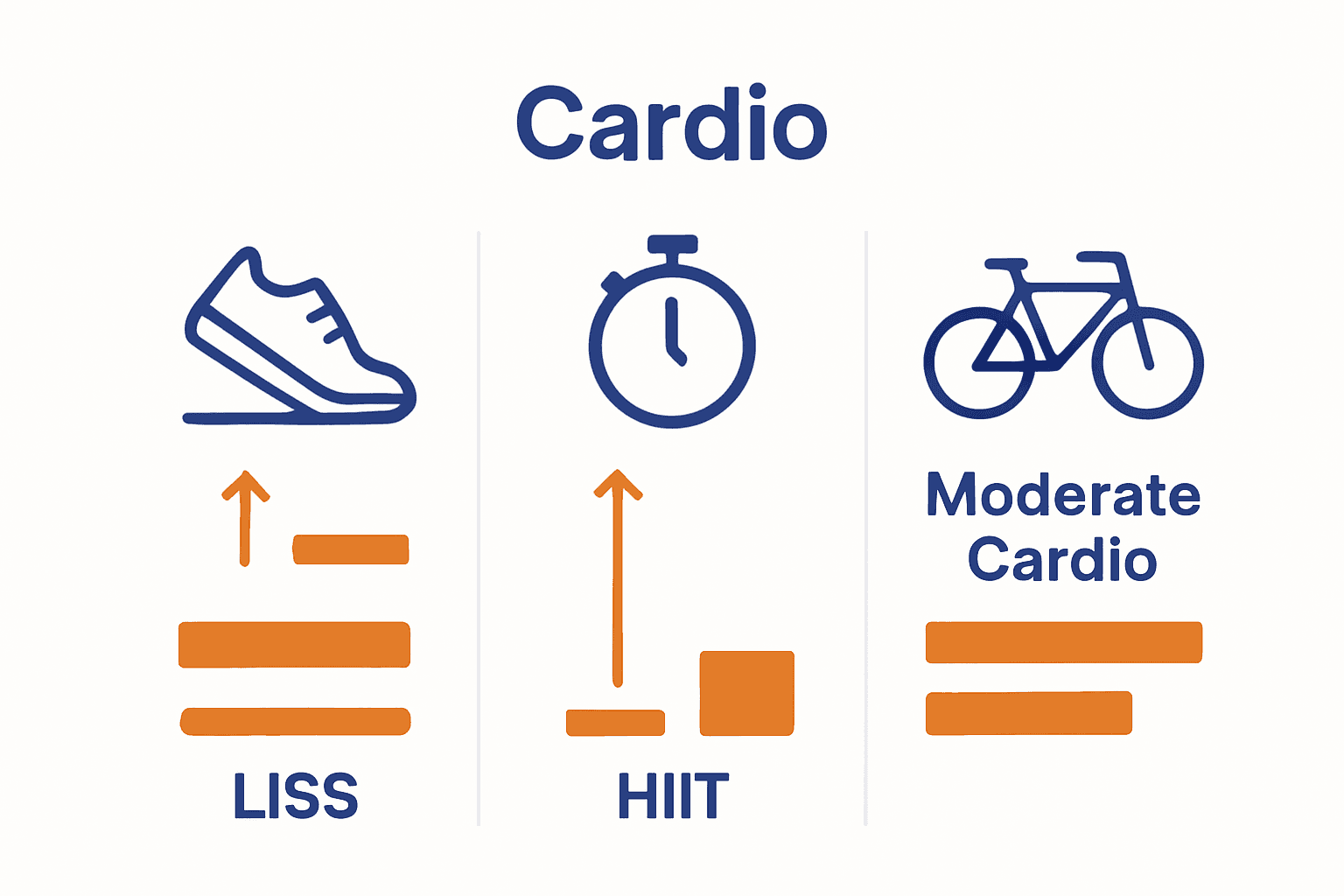Did you know that over 70 percent of people struggle to maintain weight loss from cardio alone?
Cardio can torch calories, but the real science behind fat loss goes deeper.
Understanding how different forms of cardio impact your body allows you to find the most effective and enjoyable way to shed fat.
A smarter strategy matches workouts to your personal needs, helping you slim down faster while protecting your energy and motivation.
Key Takeaways
| Point | Details |
|---|---|
| Energy Deficit is Key | Fat loss occurs when you burn more calories than you consume, with cardio significantly increasing overall energy expenditure. |
| Personalization of Cardio | Your cardio strategy should be tailored to your fitness level, individual metabolism, and personal goals for sustainable results. |
| Mixing Cardio Types | Combining different styles of cardio, such as LISS and HIIT, offers a comprehensive approach that enhances fat loss and maintains engagement. |
| Avoid Common Mistakes | To optimize fat loss, avoid overtraining, ensure adequate recovery, and prioritize nutrition alongside varied cardio workouts. |
Table of Contents
- Understanding Cardio and Fat Loss Principles
- Types of Cardio Exercises for Fat Loss
- How Cardio Promotes Effective Fat Burning
- Choosing the Right Cardio for Your Body
- Maximizing Results and Avoiding Mistakes
Understanding Cardio and Fat Loss Principles
Cardio exercises are more than just moving your body – they’re strategic tools for transforming your metabolism and burning fat.
Fat loss fundamentally occurs when you create an energy deficit, where your body burns more calories than it consumes.
Cardiovascular exercise plays a crucial role in this process by increasing your overall energy expenditure and boosting your metabolic rate.
At its core, fat loss happens through a combination of factors: caloric deficit, metabolic efficiency, and exercise intensity.
Cardio helps accelerate this process by:
- Burning calories during the actual exercise
- Increasing metabolic rate for hours after the workout
- Improving cardiovascular health
- Enhancing insulin sensitivity
- Supporting muscle preservation during weight loss
Not all cardio is created equal. High-intensity interval training (HIIT) and steady-state cardio offer different benefits for fat loss.
Learn more about how cardio intervals boost fat burning and discover which approach might work best for your fitness goals. The key is finding a sustainable approach that challenges your body while remaining enjoyable and consistent.
Successful fat loss through cardio requires understanding your body’s unique response to exercise. Individual factors like age, current fitness level, existing muscle mass, and metabolism significantly influence how effectively you’ll burn fat.
Your cardio strategy should be personalized, progressive, and designed to gradually increase your overall fitness and metabolic efficiency.
Types of Cardio Exercises for Fat Loss
Cardio exercises come in multiple variations, each offering unique benefits for fat loss. Understanding these different types helps you design a more effective and enjoyable fitness strategy that keeps your body challenged and metabolism active.
The primary categories include low-intensity steady-state (LISS), high-intensity interval training (HIIT), and moderate-intensity continuous training.
Low-Intensity Steady-State (LISS) Cardio
LISS involves maintaining a consistent, low-to-moderate pace during activities like:
- Walking
- Light jogging
- Swimming
- Cycling at a steady speed
- Elliptical training
These exercises burn calories gradually and are excellent for beginners or those recovering from injuries.
Learn more about high-intensity interval training strategies to complement your LISS workouts and boost overall fat loss potential.
High-Intensity Interval Training (HIIT)
HIIT involves short, intense bursts of activity followed by recovery periods.
This approach is incredibly efficient for fat burning because it:
- Increases metabolic rate
- Triggers excess post-exercise oxygen consumption (EPOC)
- Requires less total workout time
- Preserves muscle mass
Examples of HIIT exercises include sprint intervals, burpees, mountain climbers, and jump rope circuits. The key is alternating between high-intensity effort and active recovery, which keeps your body guessing and metabolism firing.
The most effective fat loss strategy involves mixing different cardio types. By incorporating both LISS and HIIT, you create a well-rounded approach that prevents workout monotony, challenges different energy systems, and supports consistent fat loss.
 Remember, the best cardio is the one you enjoy and can consistently perform.
Remember, the best cardio is the one you enjoy and can consistently perform.
Here’s a comparison of the primary cardio types for fat loss:

| Cardio Type | Intensity & Structure | Key Benefits | Best For |
|---|---|---|---|
| LISS | Low to moderate Steady pace |
Gentle calorie burn Easy recovery Beginner-friendly |
Beginners Injury recovery Building endurance |
| HIIT | High intensity Short bursts + rest |
High calorie burn Metabolic boost Time efficient |
Advanced Fat loss plateaus Busy schedules |
| Moderate Continuous | Moderate Non-stop, consistent pace |
Balanced challenge Improves stamina Accessible |
All levels General health Steady progress |
How Cardio Promotes Effective Fat Burning?
Understanding how fat burning occurs requires insight into your body’s complex metabolic processes.
Cardio exercises trigger a sophisticated chain reaction that transforms stored fat into usable energy, making them a powerful tool for weight management.
When you engage in cardiovascular activities, your body shifts from using readily available glucose to accessing stored fat reserves.
Metabolic Mechanisms of Fat Loss
Cardio promotes fat burning through several key physiological mechanisms:
- Increased Metabolic Rate: Exercises elevate your metabolism during and after workouts
- Hormonal Regulation: Cardio helps balance insulin and cortisol levels
- Mitochondrial Efficiency: Enhances cellular energy production
- Lipolysis Activation: Triggers fat breakdown processes
Energy Expenditure and Fat Oxidation
Your body burns fat most effectively when you maintain moderate-intensity exercise that keeps your heart rate in the fat-burning zone (typically 60-70% of maximum heart rate).
Learn more about how compound lifts can complement your fat-burning strategy to maximize your metabolic potential.
The duration and intensity of cardio directly impact fat oxidation. Longer, steady-state cardio sessions encourage your body to become more efficient at using fat as a primary energy source.
However, high-intensity intervals can also significantly boost metabolic adaptations, creating a more dynamic approach to fat loss.
The key is consistency, variety, and matching your cardio strategy to your individual fitness goals and physiological responses.
>>> Want to Lose Weight Like I Did??? Check Out My “Secret Fat Loss Smoothie Recipe” TODAY! <<<
Choosing the Right Cardio for Your Body
Selecting the perfect cardio strategy isn’t one-size-fits-all. Your ideal workout depends on multiple personal factors including current fitness level, age, health history, and individual fitness goals.
What works brilliantly for one person might be counterproductive for another, making personalization key to sustainable fat loss and fitness improvement.
Fitness Level Assessment
Before diving into any cardio program, consider these critical self-evaluation factors:
- Current physical condition
- Existing health limitations
- Previous injury history
- Personal fitness objectives
- Available time and resources
Matching Cardio to Your Profile
Different body types and fitness levels require tailored approaches:
- Beginners: Start with low-impact activities like walking, swimming, or cycling
- Intermediate: Introduce interval training and moderate-intensity exercises
- Advanced: Incorporate high-intensity interval training (HIIT) and complex movement patterns
Learn more about starting cardio intervals safely and understand how to progressively challenge your body. The secret is gradual progression – pushing your limits without risking injury or burnout.
Ultimately, the best cardio is the one you genuinely enjoy and can maintain consistently.
Listen to your body, track your progress, and be willing to adjust your approach. Sustainable fitness is about finding joy in movement, not punishing yourself through monotonous or uncomfortable exercises.
Maximizing Results and Avoiding Mistakes
Successful fat loss through cardio is not just about intensity, but strategic implementation.
Many fitness enthusiasts inadvertently sabotage their progress by making common mistakes that can dramatically reduce their fat-burning potential.
Understanding these pitfalls is crucial to designing an effective and sustainable cardio strategy.
Common Cardio Mistakes to Avoid
The most prevalent errors in cardio training include:
- Overtraining and insufficient recovery
- Performing the same workout repeatedly
- Neglecting proper nutrition
- Ignoring heart rate zones
- Focusing exclusively on long, steady-state cardio
Maximizing Your Cardio Effectiveness
To optimize your fat loss journey, implement these key strategies:
- Progressive Overload: Gradually increase workout intensity
- Variety: Rotate between different cardio types
- Rest and Recovery: Allow adequate muscle recovery time
- Nutrition Alignment: Fuel your body appropriately
Learn more about understanding common weight loss mistakes to refine your approach and prevent potential setbacks.
The most successful fitness journeys are built on consistent, intelligent training that respects your body’s limits while progressively challenging its capabilities.
Remember that fat loss is a holistic process.
Your cardio strategy should be flexible, enjoyable, and integrated with proper nutrition and recovery. Listen to your body, track your progress, and be willing to adjust your approach.
The goal is sustainable, long-term fitness transformation, not short-lived, intense bursts of unsustainable effort.
Unlock Faster Fat Loss With Proven Cardio Strategies
Are you tired of guessing which cardio routine truly burns fat?
If you find it hard to build a workout plan that actually triggers fat loss while keeping things interesting, you are not alone.
The article explained how mixing high-intensity training and steady-state cardio can transform your results but many people still struggle to choose the right method and stick with it.
At LeanAndFit, we bridge this gap by offering step-by-step resources and real-world programs designed for lasting success. Explore Cardio Intervals That Turbocharge Fat Burning.
Ready to see real change?
Dive into practical cardio routines or discover HIIT Sessions that match your schedule and fitness level.
Visit leanandfit.info now for expert guides, community support, and everything you need to finally turn your fat loss goals into reality. Make your next workout the turning point for your healthiest life.
Frequently Asked Questions
Q-1: What types of cardio are best for fat loss?
A-1: Both Low-Intensity Steady-State (LISS) and High-Intensity Interval Training (HIIT) are effective for fat loss. LISS is great for beginners and promotes gradual calorie burn, while HIIT offers a time-efficient and intense workout that boosts metabolism and preserves muscle mass.
Q-2: How does cardio affect my metabolism?
A-2: Cardio increases your overall energy expenditure and boosts your metabolic rate during and after exercise. It helps improve hormonal balance, mitochondrial efficiency, and activates fat breakdown processes, making your body more efficient at utilizing stored fat for energy.
Q-3: How often should I do cardio for effective fat loss?
A-3: To maximize fat loss, aim for a mix of LISS and HIIT workouts throughout the week. A general guideline could be 3-5 cardio sessions per week, with a combination of lower and higher intensity to keep your workouts balanced and sustainable.
Q-4: Can I lose fat with just cardio, or should I include strength training?
A-4: While cardio is effective for burning fat, incorporating strength training is crucial for preserving muscle mass and enhancing overall metabolic rate. Combining both cardio and strength training leads to better fat loss results and improved body composition.
Leave a Reply